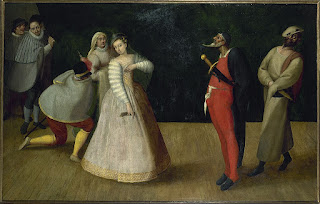Best known as father of history’s most celebrated Lothario
 |
| A painting by Tiepolo, Minuet at the Villa, taken by some to represent Zanetta and Gaetano |
From a family originally from the Aragon region of Spain, Gaetano followed the lead of his brother, Giambattista, in leaving the family home in 1713, at the age of 16. He became infatuated with a much older woman, Giovanna Benozzi, who was a commedia dell’arte actress with a touring troupe.
However, Benozzi, who went under the stage name of La Fragoletta - the Little Strawberry - was not so enthusiastic and instead married one of the troupe’s stars, Francesco Balletti, who hailed from a family of famous actors and was their specialist in the role of Arlecchino - Harlequin.
Crestfallen, the young Geatano left the troupe and went to Venice, where he found work at the Teatro San Samuele.
In the event, it was not long before he found a new romantic interest, this time in the daughter of a shoemaker who kept a workshop near where Gaetano was staying. Her name was Zanetta Farussi.
Zanetta’s parents did not approve of their relationship, yet after less than a year they were married in secret. Her father, Girolamo, died not long afterwards, supposedly from a broken heart. Gaetano persuaded her mother, Marcia, to accept the marriage only by promising that she would not follow him into the acting profession.
 |
| Francesco Casanova's painting, The Cavalry Battle, is currently on display at The Louvre |
Indeed, Michele paid such attention to Zanetta that when she and Gaetano’s first child, Giacomo, was born in 1725, he suspected that Michele might be the real father.
Nonetheless, he and Zanetta stuck together and teamed up with a popular acting company to go on tour in London, where their second child, Francesco, was born in 1727. Giacomo stayed behind in Venice, in the care of the Grimani family.
They went on to have six children before Gaetano died, sadly, at the age of only 36 after developing an infection that stemmed from an ear abscess.
Of the six children, Francesco and Giovanni both went on to become well known in their own right as painters.
Francesco, who trained initially in the workshop of the Venetian painter Giovanni Antonio Guardi, made his name painting battle scenes, a skill he learned from working with Francesco Simioni. At the height of his popularity, he sold paintings to King Louis XV of France and was commissioned by Catherine the Great of Russia.
 |
| Giacomo Casanova, whose parentage was unclear |
Yet their places in history have largely been eclipsed by their brother, Giacomo, whose colourful life after graduating from the University of Padua with a degree in law saw him work at various times as a clergyman, military officer, violinist, businessman and spy.
He frequently embarked on passionate and risky affairs with women, who were often already married. He would regularly run out of money and on several occasions was imprisoned for debt.
 |
| Prosciutto di Parma, the ham that had become one of the edible symbols of the Emilia-Romagna city |
Parma, where Gaetano Casanova was born, is an historic city in the Emilia-Romagna region, famous for food and music among other things. The home of Prosciutto di Parma ham and Parmigiano Reggiano cheese, it has a music conservatory named after Arrigo Boito, who wrote the libretti for many of the operas composed by Giuseppe Verdi, who was born near Parma at Busseto. Parma also has a prestigious opera house, the Teatro Regio. The city was given in 1545 as a duchy to the illegitimate son of Pope Paul III, whose descendants ruled Parma till 1731. An elegant city with an air of prosperity common to much of Emilia-Romagna, Parma’s outstanding architecture includes an 11th century Romanesque cathedral and the octagonal 12th century baptistery that adjoins it, the church of San Giovanni Evangelista, which has a beautiful late Mannerist facade and bell tower, and the Palazzo della Pilotta, which houses the Academy of Fine Arts, the Palatine Library, the National Gallery and an archaeological museum.
 |
| How the Teatro San Samuele may have looked when Gaetano Casanova was an actor and dancer |
The Teatro San Samuele, where Gaetano Casanova found work on his arrival in Venice and where his wife, Zanetta Farussi, began her theatrical career, was an opera house and theatre at the Rio del Duca, between San Samuele and Campo Santo Stefano. It was first opened in 1656 in Venice and the playwright, Carlo Goldoni, was the theatre’s director between 1737 and 1741. The theatre was destroyed by fire in 1747 but then rebuilt and it remained a theatre until the building was demolished in 1894. San Samuele is in the San Marco sestiere and has a waterbus stop on the right bank of the Grand Canal before you reach the Rialto. The San Samuele is one of three Venice theatres from its 18th century golden age - along with the San Moisé and San Cassiano or the San Samuele - that no longer exist. The San Benedetto closed in the early 20th century and was remodelled as a cinema. Renamed Teatro Rossini in 1868 in honour of the composer Gioachino Rossini, it reopened as the Cinema Rossini in 1937. Nowadays, the building, in Salizzada de la Chiesa o del Teatro, which is between Teatro la Fenice and the Grand Canal in the San Marco district, holds a multi-screen cinema.
Also on this day:
1696: The birth of soprano Francesca Cuzzoni
1725: The birth of adventurer Giacomo Casanova
1894: The death of painter and printmaker Achille Vianelli
1959: The birth of Olympic marathon champion Gelindo Bordin
.jpg)

.djvu.jpg)




_-_2021-08-28_-_2.jpg)












